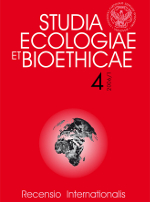Stan biologiczny populacji ludzkich a przemiany środowiska społeczno-ekonomicznego
Biological status of human populations and changes of the socio-economic environment
Author(s): Anna Siniarska, Napoleon WolańskiSubject(s): Anthropology, Human Geography, Human Ecology
Published by: Wydawnictwo Naukowe Uniwersytetu Kardynała Stefana Wyszyńskiego w Warszawie
Keywords: human ecology; phylogeny; ontogeny; mutation;selection;
Summary/Abstract: Adaptation of life to the environment occurs at two levels - that of an individual and that of a population. In the first step of the process of adaptation variability is produced. It provides necessary material for the second step - selection. Variability is generated during the phylogeny, from one generation to the next. However, variability can also be generated during individual ontogeny at least by protective mechanisms of instinctive behaviors of animals and conscious cultural human actions. Variability originates from point mutations and chromosomal aberrations occurring during transmission of genetic material from generation to generation and through activation, or deactivation, of genes that alters their expression. This variability determines phenotypic differences among individuals. Variability thus produced is subjected to selection because how a phenotype is formed determines its ability to survive and to produce offspring. In human populations, adaptation occurs via biological and via cultural processes. Humans with their culture - especially medicine and social care - protect lives of individuals who otherwise would have been eliminated by natural selection.Hereditary differences among various geographic groups of modern people occur with low frequency - just a fraction of a percentage point. From observations of phenotypes it can be concluded that both structural alterations in the DNA and differences in gene expression cause variations, the majority of genes are inactive at various stages of ontogeny, while various portions of the genotype become active at different times in the life of an individual.Environment influences variation in three ways: (1) by causing mutations or by altering gene expression and (2) by providing conditions for the formation of a phenotype coded by a particular genotype and (3) as a factor of selection, including occurrence of cultural behaviors modifying effects of natural selection. It seems that the main aim of future research in human ecology should be search for the answer to following questions: 1. Can gene expression be changed during ontogeny? 2. To what extent such changes can be inherited? 3. To what extent is there an increase in the occurrence of genes that do not allow survival without special care (genetic load), and 4. How will all this influence future of our species?
Journal: Studia Ecologiae et Bioethicae
- Issue Year: 4/2006
- Issue No: 1
- Page Range: 17-41
- Page Count: 25
- Language: Polish

